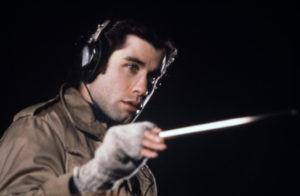STUDIO: Criterion | DIRECTOR: Brian De Palma | CAST: John Travolta, Nancy Allen, John Lithgow, Dennis Franz, Peter Boyden, Curt May, John Aquino, John McMartin
RELEASE DATE: 9/6/22 | PRICE: DVD (previously released, 2011) $16.89, 4K/Blu-ray Combo $34.99
BONUSES: Interview with director Brian De Palma, conducted by filmmaker Noah Baumbach; interview with actor Nancy Allen; Murder à la Mod, a 1967 De Palma feature; interview with cameraman Garrett Brown on the Steadicam shots featured in the film; on-set photographs by Louis Goldman
SPECS: R | 108 mins | Thriller | 2.40:1 | 2.0 Surround
Blow Out (1981) is one of several movies by Brian De Palma that counterpoints a harsh, violent plot with smooth (one might even say elegant) camerawork and beautifully composed images. Much was made in the Seventies and Eighties of De Palma’s seemingly slavish (and acknowledged) devotion to Hitchcock’s work, but what that left out was his (equally acknowledged) borrowing from other titans of cinema. Here he overlays a very Chappaquiddick-like incident over a plotline borrowed from both Antonioni (from writer Julio Cortazar) and Coppola, with his own noir vision of the world.
The premise is simple and is indeed a flagrant riff on both Blow Up (1966) and The Conversation (1974). A schlock movie sound editor (John Travolta) is told to find new sounds for a movie soundtrack and accidentally witnesses and records a suspicious car accident involving a governor who is challenging the President for his party’s nomination. The plot is complicated by the editor falling in love with a pretty girl (Nancy Allen) who was in the car with the now-dead governor.
The film’s visuals remain its strongest suit — most likely the reason the film has been put out in the burgeoning 4K format by Criterion (backed up by the Blu-ray watched by this reviewer). By this point De Palma had surpassed his fine work with split screen to introduce split diopter shots in which a person or object in the foreground is in perfect focus on one side of the screen and a person or object in the background is in perfect focus on the other side. These shots work to increase the tension at certain moments but they also carry an emotional weight that moves the story forward.
De Palma’s careful concentration on visual stylization has often eclipsed his screenwriting abilities, so what begins as a political thriller degenerates into a pure slasher film focused on the psycho (a young and quietly menacing John Lithgow) recruited to scare the governor who ends up killing him by shooting out his tire.
 Certain scenes seem included merely to thrill slasher-flick fans (and outrage feminists, in the mode of De Palma’s later Body Double), including a tangential sequence that has nothing to do with Travolta’s discovery or the plot as a whole. Lithgow’s character sees a woman who looks like Allen and cold-bloodedly stalks and kills her in a train station ladies room.
Certain scenes seem included merely to thrill slasher-flick fans (and outrage feminists, in the mode of De Palma’s later Body Double), including a tangential sequence that has nothing to do with Travolta’s discovery or the plot as a whole. Lithgow’s character sees a woman who looks like Allen and cold-bloodedly stalks and kills her in a train station ladies room.
Thus, the film’s premise — which surely seems to be introducing a political aspect, commenting on possible governmental involvement in political assassinations — disappears in the third act, so we can follow the machinations of the “big chase” at the film’s end, in which Travolta has sent Allen’s character out with a wire to act as bait for the killer. A foolhardy and dangerous move, to be sure, but also one that removes any level of politically-themed paranoia from the plot and reduces Blow Out to an impeccably shot and edited “race against time” picture.
The supporting cast do much to make their characters believable. Dennis Franz plays an amiably sleazy photographer who caught the car accident on film and also helped set up Allen’s character with the governor. Lithgow gives a measured performance, only fully turning on his psycho energy during the moments of pursuit. Allen clearly labored to make her character seem like a real person, but De Palma scripted the character to be little more than a bimbo lost in the big city.
The film’s lasting legacy, besides the gorgeous diopter shots, is the lead performance by John Travolta. An actor who has an incredibly limited range, Travolta was put to the test here and created a suitably jaded character whose final, remarkably cynical action rings true (and oh, so noir) because of the actor’s willingness to stretch. Much was made of his uneven “comeback” in Pulp Fiction, but his work here surpasses his mannered work in Tarantino’s big hit.
This package, which was first released on DVD in 2011 and has been upgraded for Blu-ray and 4K, contains three original supplements and one vintage feature. The latter is the early De Palma feature Murder a la Mod (1968). The film is both a comedy and a thriller (and is seen briefly on a television in Blow Out), and tries to spoof sexploitation without becoming sexploitation itself.
It is slower paced than De Palma’s comedies from the same period, Greetings (1968) and Hi Mom! (1970), and contains various narrative gimmicks. The most prominent one is that we move back and forth in time, seeing different perspectives on different events — De Palma here borrowing the skewed timeline device that was first used in Stanley Kubrick’s The Killing (1956) and was later borrowed by Tarantino for his first four features.
The most interesting supplement for film nerds and De Palma diehards is an interview with Garrett Brown, who invented the Steadicam. He also operated the device for Kubrick’s The Shining and says he went straight from that film to Blow Out, where he shot both the final chase and the opening sequence, which shows the T&A slasher movie on which Travolta’s character is working. The slasher-movie sequence incorporates a lot of action and was a variation on Halloween (as were all slasher films made after it was released), which Brown calls “a great bit of fun filmmaking.”
Nancy Allen is quite upbeat in another supplement, discussing at length her journey into her “sad little girl” character, which she says was a difficult procedure. She says she finally found the way “into” the character by thinking of Judy Holliday in Born Yesterday and Giulietta Masina in La Strada.
She notes that the biggest battle on the set of the film was whether or not the lead characters would have a romance. She and editor Paul Hirsch voted for the romance (due to the “natural chemistry” she felt with Travolta) but De Palma and Travolta did not, and so a compromise was struck —wherein the characters seem to really like each other and will probably have a romance once all this mess is over. She declares that the compromise “never satisfied me.”
 She recounts her claustrophobia during the scene where her character nearly drowns when the governor’s car hits the water. (Travolta’s character saves her.) Although paralyzed with fear, she did the scene rather well but let a double do the more demanding moments of floating.
She recounts her claustrophobia during the scene where her character nearly drowns when the governor’s car hits the water. (Travolta’s character saves her.) Although paralyzed with fear, she did the scene rather well but let a double do the more demanding moments of floating.
Her final verdict on the film is that it is a “classic” where “everything works.”
De Palma presents his anecdotes about the film to Noah Baumbach in another onscreen supplement. He explains that the premise for the film came from a discussion he had with his own sound man on the set of his preceding film, Dressed to Kill, where he ended up requesting “new sounds.” He discusses in detail the opening slasher-movie parody, Allen’s claustrophobia during the car accident sequence, and the split diopter shots.
He stresses that he’s always searching for a “great idea” for a film and that he felt that Blow Up and The Conversation were that kind of idea, but that he wanted to show the killing (via the accident) in more detail than was done in those films. He attributes the political assassination angle to his Sixties fascination with alternate theories about the JFK assassination, but curiously never utters the word “Chappaquiddick” once about a film that so clearly models its key sequence on the real-life 1969 incident where Senator Ted Kennedy accidentally plunged his car (with a woman in the passenger seat) into a channel connecting two ponds.
The best story concerning the film involves parts of its negative being stolen. They were never recovered, and so De Palma had to do the rather lengthy scenes in the woods and the final chase sequence (set against the annual Mummers parade in Philadelphia) all over again.
There’s still some of the un-p.c. provocateur in De Palma, who, toward the end of the interview, strives to define what filmmakers do that other artists don’t, concerning female characters (namely, make the viewer fall in love with a character, then eliminate her). He summarizes it thus (and does straightforwardly say “it,” not “her”): “It’s one of the basic tools of movies. It’s Godard[’s quote about the raw elements of a film plot], you know… a gun and a girl. With a gun, when’s somebody going to fire it? With a girl, when’s somebody going to undress it? So… that’s movies.”
|
Buy or Rent Blow Out
on DVD | 4K/Blu-ray Combo
|
|---|
Leave a Reply